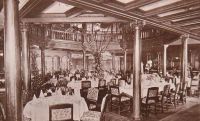The RMS Aquitania was built in 1914 and at the time of launching,
she was considered to be one of the most beautifully decorated liners ever to go to sea. She survived both wars and was the
last of the great four-stackers. She was broken up in Faslane, Scotland in 1951.
Prior to the break-up, her furnishings and fittings were auctioned
off in England by Hampton and Sons, Ltd., on January 9th, 1950. At that time, almost everything passed into private hands
and now rarely surfaces. (Much of the oak paneling and fittings from the famed Elizabethan Grill are now in the aptly named
Elizabethan Lounge of the Parkway Hotel in Sandown, Isle of Wright, England.)
This capital was purchased at an auction of ocean liner items in the
South of England in 2003. The auction included part of the collection of the late Bill Childerstone of Southampton. An auction
firm based in Miami, Florida purchased three of these wooden capitals and the most stunning of the three I purchased from
them in 2004.
Bill Childerstone owned a company based in Southampton which serviced
ocean liners in that port. While the nature of the services are sketchy, Mr. Childerstone accumulated a vast collection of
memorabilia from these liners. This beautifully carved capital would have been fitted to the top of a wall near the ceiling
and would have been part of a large carved ceiling molding, possibly a fluted column. It is believed to have come from the
Second Class Gentlemen's Smoking Lounge, but efforts to pinpoint its exact location have proven fruitless.
It is expertly carved. The main block of the capital has a deep and
heavily carved gargoyle decorating the base. Flaring nostrils, a bulbous nose and deep set eyes are all carved out of this
one very heavy piece of oak. Rising up above this is a stepped base with additional fluted carving and a cornice top, all
carved from the same piece. There are three carved and decorated scrolled arms with acanthus leaf carving that extend out
from either side and the front of the main block. The overall look is of rich, dark oak with a low sheen and a nice patina
indicitave of its age. A handsome architectural carving and an important piece of ocean liner memorabilia.

